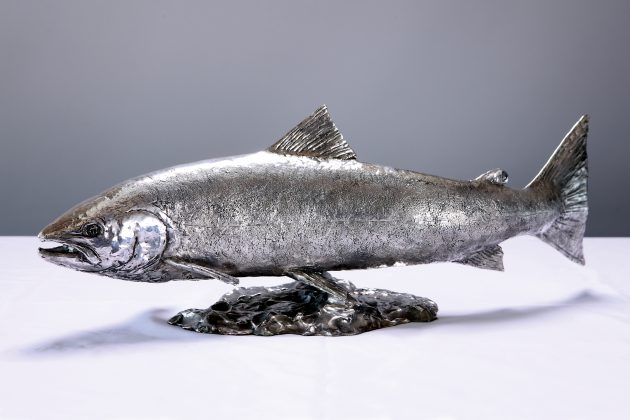David Williams-Ellis’ sculptures of fish and fishing celebrate the past but he hopes they will also help change the future.
Britain is fishy. The UK is about 94,000 square miles in area but has a coastline of around 10,000 miles (depending how you measure it). Nowhere is more than 70 miles from the sea, and even those bits that are that far inland are connected by a wide network of freshwater and tidal rivers. One of our very first industries was fishing; indeed, the Worshipful Company of Fishmongers reached its 750th anniversary last year. To celebrate that landmark (or should it be watermark) the Company turned to sculptor David Williams- Ellis to create a sculpture showing the whole industry, both inshore and offshore, including all the people, especially women, and the vast number of different fish species involved. The finished work, called The Catch, is now in place at Fishmongers’ Hall in London.

As a keen fisherman himself, David Williams-Ellis was the ideal choice. He says: “That was such an interesting and exciting piece to develop, trying to get a composition of the fish and the people working.” The project was a natural follow-up to his earlier commission for Aberdeen City Council of a woman with a basket of fish and a man hauling in a catch. Williams-Ellis explains: “The sculpture for Aberdeen was to celebrate the port’s past fishing industry. Aberdeen was a huge fishing port but now it is only oil workers and wind turbines, and the fishing fleets have gone. But the city wanted to celebrate the fishing community that had been such an important part of its history.

“I had great fun doing it because I could order every species of fish that I love and get in hake or cod or haddock – if you look carefully you can see the different varieties in the baskets and the net the fisherman is holding in his hand. But it is terrifying how a fishing fleet can be wiped out. A £100m factory fishing ship can wipe the salmon from a whole river, they can wipe out a whole breeding population. These ships track the fish by satellite, and the population on the rivers is threatened. I have spent a lot of time in Kenya, and the Chinese fishing fleet has come in off Kenyan shores and destroyed that population.”

Increasingly it seems as if the 11th hour for fish has already passed, so it is difficult to report the situation with any kind of positivity, but David Williams-Ellis has a clear view of his two-fold role: “As a fisherman you have the love of being on a river and watching it through the long hours you spend on the water. And you see it also as an artist, observing everything around you, the shapes of the stones in the water and the movement of the river. The other side is recording history, and I am about celebrating the past more than making a direct protest about what is happening to the fish. I hope that by focusing attention on these individual creative images of fish and fishing, I can bring attention to the situation. You can’t catch 60lb salmon in British waters any more, as you did 150 years ago.”
One of Williams-Ellis’ most successful pieces is of just such a record fish. Titled Eden Salmon and commissioned by the Eden Rivers Trust, it commemorates the largest English salmon, fly-caught on the River Eden in the 19th century. The cock salmon, with a pronounced kype, swims impassively across the landscape, with a hen fish swimming alongside. David Williams-Ellis explains: “It has the idea that there is a personality there. I have fished a lot and you get an insight into how fish move, and I wanted to get a feeling of power and the movement in that massive tail.”

His two current projects are even bigger. He is doing an enormous footballing sculpture for one of our leading Premier League teams, whose name is yet to be revealed. The other is a new work in the ram’s head collection to which he returns. “It will be an 8m by 4m ram’s head to go into a private parkland setting in England in the autumn. So there is a lot of excitement going on. You do get daunted, but the challenge pulls you through. I find it incredibly rewarding. I am looking at my big sculptures at the moment and you wonder how you have made them. As a sculptor you never stay in one position; you are running back and forth round the sculpture as it develops. You are climbing up and down scaffolding, and it is amazing how fit you get. I am often hanging upside down and high up, working on a particular element.”

If that is reminiscent of the great Renaissance sculptors dangling by a rope from a ceiling to sculpt a nose or capture the touch of a finger, it does indeed go back to the start of Williams-Ellis’ career: “I went straight from school to Italy and worked with the marble workers of Carrara, living in the community, and a group of international artists drawn by the marble. It was an inspiring start.”
The work of David Williams-Ellis is on display in various public settings. For further details, visit: dwe.com




